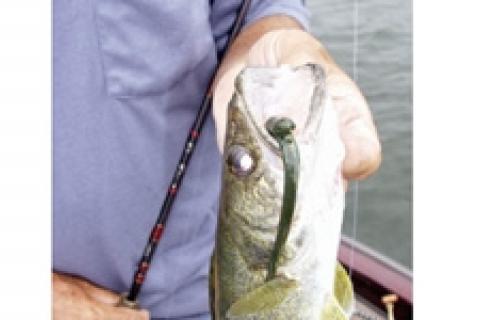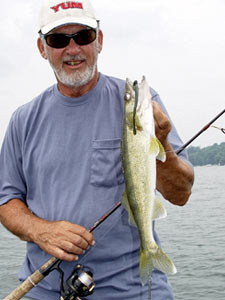
Though the popularity of drop-shot rigging came about as a finesse tactic for pressured bass waters, the notion of suspending a bait above the sinker has found numerous applications when pursuing other species, our favorite glassy-eyed friend included. From natural lakes and reservoirs that feature a combination of rocks and weeds, to large river systems replete with both natural and man-made structure, drop-shot rigs catch walleyes.
 |
|
Though thought of as a bass tactic, drop-shot rigging is also effective on walleyes. Dave Lehman took this 'eye along the weedy edge of a hump in Pennsylvania's Conneaut Lake. |
Drop Shot 101
For those who don't venture far from traditional walleye rigging methods, the drop-shot rig is one where the hook is tied a distance up the line, while the sinker is attached at the line's end. The spacing between the two terminal components varies, depending upon how far one intends to present the bait up off the bottom.
Hooks styles differ, based on both the type of bait being fished, as well as the cover. Hook makers produce special drop-shot hooks, which typically feature a short shank, fairly wide gap, and light wire construction, keeping with the finesse aspect of the presentation. But other styles can be used, particularly when fishing around weeds and rocks, where hanging up is a consideration. The hook is tied to the line with a Palomar knot, with the gap of the hook pointed up.
Drop-shot sinkers, like hooks, have become a specialized deal. You can get them both round and mojo (cylindrical) shape. Lead and tungsten are the two primary construction materials. Drop-shot sinkers feature a special tapered eyelet that allows the sinker to be affixed to the line without a knot, making it a simple matter to adjust to a different size or shape of sinker when conditions change.
A diversity of soft-bodied baits can be fished via the drop shot, though the tendency is to go with smaller, finesse-style options. Natural baits too can be presented with a drop shot.
Stillwater Drop-Shotting
Frequent fishing partner Dave Lehman frequently impresses me with the many methods by which he catches fish, so when walleyes fell to a drop shot rig he was dragging along the edge of a weed fringed mid-lake hump, it wasn't much of a shocker. And this lake has a marginal walleye population too.
Lehman picks his drop-shot-rigged rod up from the collection that litter the deck when he's working the outside fringe of weed cover, typically fingers of growth that splay off from the edge. This provides a network of miniature points and cuts, with the 'eyes often being tucked back inside these inside turns. The drop shot can be pitched up into the shallows, and dragged back off of the break.
According to Lehman, who often tests the action of baits and riggings in ponds located on his property, one of the distinct advantages a drop shot is the ability to soak a soft-bodied bait and still have it provide motion.
"Even if you are not moving, the bait is still moving around," he noted. "That's not always the case if the bait is lying on the bottom, especially if the bait is competing for room with low lying weeds."
Lehman has his greatest confidence in more buoyant soft plastic baits, ones that offer good movement with little to no aid from the angler. A favorite of his is the Roboworm, a thin-bodied worm in which the salt slowly dissipates as it is fished.
For fishing the thin plastic worms that he prefers, in the weed-fringed habitat, Lehman shies away from the use of specialty drop shot hooks, in favor of a standard No. 1 offset worm hook.
"If I were fishing the same worm on the bottom, for bass, I'd probably use a 2/0 hook," he said. "But for the drop shot, scaling back to this smaller hook provides an offering where the hook hardly even seems to be there. It doesn't weight the worm down, allowing lots of motion." He rigs the hook Texas-style weedless.
Frank Scalish makes his living bass fishing. But the Cleveland, Ohio, pro angler pursues a variety of species. And when he's targeting walleyes on natural lakes that contain beds of submerged vegetation, he commonly relies on the drop-shot rig. In many ways his approach is similar to Lehman's, with a few added twists and details.
On northern natural lakes Scalish has found June and July to be the best months for taking weed-oriented walleyes on the drop shot. He looks for rock ledges that extend off the outside edge of the weeds.
"I catch them up in the weeds at times, but for the most part they are coming on the rocky shoals located off of the grass cover," explained Scalish. "Essentially you are structure fishing, working irregularities in the weedline. Isolated clumps of weeds tell you that there is a change in bottom composition, which can be a gold mine."
Scalish's lure choices are simple: a three-inch Yum Dinger or a four-inch Yum Houdini Worm. Color preferences are watermelon, green pumpkin purple, or Mardi Gras, which is basically watermelon with gold and purple flakes. He prefers a round sinker to a mojo style, admitting that though the round shot may gather more weeds, it transmits bottom feel better. For this same reason he uses the harder, tungsten weights.
In Scalish's mind, the key ingredient in the drop-shot presentation is the ability to show walleyes a bait off of the bottom. Being flexible in regard to the spacing issue is critical.
"Sometimes they want the bait 6 to 10 inches away from the sinker," he noted. "At other times they want it three feet away. I've found that walleyes feed up. So it's better to have a bait just above them than just below." He added that if you can see fish on your locator, and you're not getting bit, it's time to begin lengthening hook-to-sinker distance.
Scalish uses a seven to seven-foot, three-inch medium action spinning rod for pitching drop shots. The reel is spooled with 10-pound test Silver Thread fluorocarbon. He keeps two rods rigged for drop shots. One is rigged with a Gamakatsu open-style drop shot hook, either 1 or 1/0, in which case he nose-hooks the bait. For working tighter to weedy cover, he opts for an outfit with a EWG (extra wide gap) style worm hook, which he rigs Tex-posed. This hook allows for sweep hooksets, rather than requiring a power set to drive the point through the worm.
Flowing Water Drop-Shotting
Walleye pro angler Keith Eshbaugh, from Washington, Pa., plies the impounded rivers of western Pennsylvania with a variety of presentations, drop shots being one of them. In a watery world where jigs reign, Eshbaugh has found a niche for the drop-shot rig.
According to Eshbaugh, when baitfish stack up on man-made structure like bridge piers and barge pilings, drop shots can be the best way to catch the walleyes keying in on the forage.
"This happens a lot during the summer, when the bait and the walleyes prefer the current that's funneled through these areas," he claimed.
Since bait tends to suspend along the sides of these structures, a jig fished along the bottom will miss the walleyes feeding there, unless the fish happens to take the jig on the fall. A drop shot is ideal for presenting the bait at or just above walleye level.
How Eshbaugh works a pier or piling depends on its physical nature and size. For smaller piers, especially if the depth is moderate and the current on the mild side, he will hold the boat at the upriver end of the structure, pitch the rig in, and allow it to drift along the pier's side. For larger piers, or where the current is sweeping the rig away too fast — resulting in a loss of feel — he'll fish it vertically as the boat slips with the current.
In mild currents, typical of summer conditions, Eshbaugh goes with an eighth to quarter-ounce round lead drop shot sinker. He uses a No. 4 Gamakatsu octopus-style hook. His soft bait of choice has been a three-inch Berkley Gulp! Minnow in smelt or black shad. He starts off with a one-foot hook-to-sinker spacing and works up from there, depending on feedback from the sonar as well as walleye bites. He'll stretch things out as much as three feet. Eshbaugh ties his drop shots directly to pink 10/4 Fireline when fishing rivers.
I would add that drop shots are a good way of fishing large redtail chubs in rivers during the late fall. Use a No. 2 or 4 circle hook, and drag the bait downriver at an angle through slackwater pools. Wait for the fish to move away from you, or for the boat to drift away from the fish, before tightening up the line, the mechanism that sinks the circle hook into the corner of the fish's mouth.
- 11328 views

